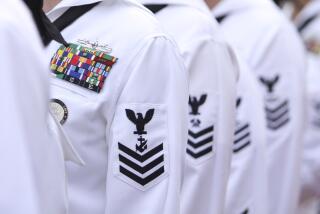Fitness Program Launched to Combat Stress Aboard Ship
- Share via
LONG BEACH — Confined to 120-degree boiler rooms, restricted to tiny cubicles for hours on end, forced below deck for weeks at a time, the sailors on the battleship New Jersey became a study of what long periods of stress and inactivity can do to an otherwise able-bodied crew.
While serving off Lebanon last year, many crew members became lethargic, overweight, irritable and physically weak, Navy spokesmen said. Their ordeal, however, has helped forward the Navy’s research into solutions to fitness problems that often strike sailors during months at sea.
The 1,500-member crew of the New Jersey, which returned to Long Beach last May after one of the longest duties at sea since World War II--11 months, including six within range of enemy guns off Lebanon--came home looking for better ways to stay in shape.
Seven months later, the battleship is in the forefront of an exercise program that was spotlighted aboard the New Jersey on Thursday by the President’s Council on Physical Fitness and Sports.
Weightlifting Regimen The New Jersey’s program--unveiled with much pomp and the presence of former Washington Redskins football coach George Allen, the council’s chairman--is a weightlifting regimen. It takes place in a small, one-time storage room that is now a gym of baby blue paint, shiny chrome and mirrored walls.
The workouts on specially adjusted Universal weight machines have been tested aboard other ships with striking success--30% increases in strength, flexibility and endurance within three months--for almost two years, said Lt. Ed Marcinik, a physiologist at the Navy Health Research Center in San Diego and a developer of the program.
But its adoption by the New Jersey is in a sense “its inaugural,” because the battleship is the first major Navy vessel to adopt the voluntary, 15-minute, tightly disciplined circuit of weight training.
It is also a significant advance for the ship, said Capt. Richard Milligan. “As big as the battleship is, up until this time we have not had a dedicated area for working out,” he said.
“This is a new program and truly the culmination of what we’ve been trying to do,” Milligan said. “I think the Navy learned a lot from our deployment and has taken that (into) its whole program.”
That step forward for the New Jersey was born of difficult times, said Lt. Eric Massa, the ship’s “fitness officer,” a title coined within the last two years as the Navy has redoubled its emphasis on physical fitness.
“This started because we were off Beirut for so long in wartime status,” said Massa. “We found the guys were getting out of shape, and it was affecting their ability to do their jobs.
‘This started because we were off Beirut for so long in wartime status.’ --Lt. Eric Massa “Guys were gaining a lot of weight and becoming lethargic. People were very, very tense, and it had an impact of the crew’s morale.”
The New Jersey, which was four to 10 miles off the Lebanon coast, was within range of the 130-millimeter howitzers used by the Syrians and their allies.
That meant the crew, which was never fired upon, had to stay off the main deck--where the sailors had jogged--for a month at a time, said Massa. A few weightlifting bars below deck did little to relieve the tension, he said.
“We had a crew whose average age was 20 years old--all men, all athletic,” said Massa, “and they were getting on each other’s nerves. There was no physical outlet for anyone.”
In the worst times, when there was frequent firing on U.S. Marines at the Beirut airport, the New Jersey crew was at its battle stations, ready to fire on enemy positions, for 12 hours or more every other day, said Massa.
During those times, “we had to survive in very cramped spaces,” he said. “Four or five people would be locked in what would be considered a closet for many, many hours. In a battle situation you reduce the ventilation and it would be very hot, or in the winter very cold. I would direct the guns, and I’d sit on a tractor seat and look through gun sites. I had terrible cramps in my legs.”
And, said Massa, “We found that the average sailor in combat has a hard time picking up his buddy and moving him out of fire.”
As problems of irritability, endurance and strength increased, the ship’s crew began communicating with Marcinik and the Navy Health Research Center, which since 1981 had been looking into ways to make sailors more fit, said Massa.
Through studies of new recruits and of sailors aboard ship, physiologists and doctors at the center found that an old conditioning routine--circuit weightlifting used by athletes in numerous sports--was most efficient given the time constraints of sailors and the lack of exercise space on ships, said Marcinik.
The simple program consists of a five-minute warm-up, then two rotations through 15 weight stations, which takes 15 minutes, the minimum recommended workout.
The sailors--more than 20 can work simultaneously in the Jersey’s small gym--stay at each station for 30 seconds, 15 for lifting and 15 for resting. One sailor keeps time, making sure the lifters move at the right moment, said Marcinik.
The rapidity of the shifts from station to station keeps the heart pounding at a rate fast enough to condition as well as strengthen, he said.
“(The program) is pretty old, but it hasn’t really been applied to the Navy population,” he said. “It is really important aboard ship because there isn’t much else to do. Attendance rates at workouts aboard ship have been about 90%.”
As the New Jersey’s long tour was coming to an end, the crew overwhelmingly endorsed the idea of constructing a gym on ship, said Massa.
Almost immediately upon return to Long Beach, the sailors on their own time began scraping old paint from a 25- by 30-foot storage room to create the gym, said Massa. The money for the weights, paint, mirrors and accessories also came from the sailors’ own money--the profits at the ship’s store.
More to Read
Go beyond the scoreboard
Get the latest on L.A.'s teams in the daily Sports Report newsletter.
You may occasionally receive promotional content from the Los Angeles Times.










